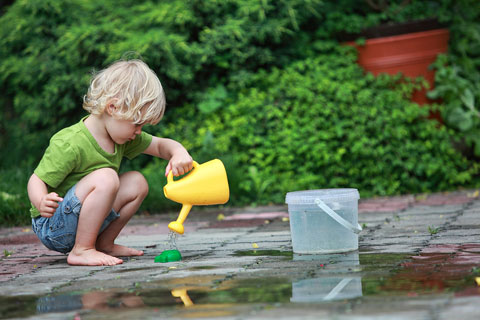Playing with materials such as water can be an important outdoor experience for preschoolers. When children play with water, they can build fine- and gross-motor skills. They can also apply some basic principles of science and engineering. (See Illinois Early Learning and Development Benchmarks 5.C.ECa, 11.A.ECa, 11.A.ECc, 12.E.ECa, and 19.A.ECa.)

Help children prepare to investigate water outdoors.
- Share nonfiction books, Web sites, and videos about water and its behavior. Ask a librarian to help you find pictures of Illinois rivers, lakes, dams, and levees to show the children.
- Invite children to plan and build models of what they see in the pictures. Help them decide what materials to use so they can contain or move water in their models.
- Introduce words such as flow, flood, dam, erode, and contain to help children describe how water moves.
- Suggest that families send “work clothes” for children to wear when they play outdoors with water. Provide plastic gloves for children who want to wear them during outdoor water play.
- Encourage safety and respect for others’ work by asking children to help make rules for water play. Supervise water play carefully. Children should always wash hands after playing in water.
Set aside part of the playground for water study.
- Pick a place where the water play will not disturb children who do not want to be wet. A space with sand or gravel may lend itself well to studying erosion.
- Try filling a small wading pool (less than 2½ feet deep) or plastic rain barrel with clean water for each day’s use. A rain barrel should have a secure lid that children cannot remove. They can get water through the spigot at the bottom. Clean and disinfect the pool or rain barrel often.
- Provide buckets, scoops, measuring cups, ladles, and shallow tubs for moving the water. Offer hoses, turkey basters, lengths of plastic gutter, and PVC pipe, including joints and elbow bends. You might ask families or businesses (garden centers, building supply stores, or contractors) to donate these items.
- Ask questions that provoke children’s curiosity. “Do you think a piece of wood will work as a dam?” “What do you suppose made your levee come apart?” “Can you make this water flow up the hill?”
Follow up on the children’s water experiments.
- Invite children to draw or take photos of what they do with water. Let them report on their water play during class meetings.
- Let children create a display about their water study for visitors to see.


 Printer-friendly PDF
Printer-friendly PDF Printer-friendly PDF
Printer-friendly PDF